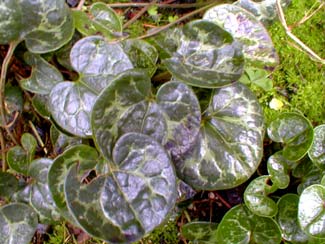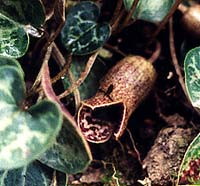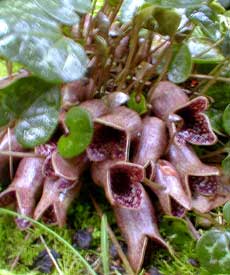 'Callaway'
'Callaway'
Mottled Ginger
Asarum shuttleworthii 'Callaway,' or Callaway Mottled Ginger, is a cultivar of Shuttleworth Ginger. It is very small compared to our Chinese Giant Asarum. 'Callaway' is only about 3 inches tall.
It is an evergreen native of the Virginias, Carolinas, Georgia & Alabama, fond of mountain & coastal plain forests along the edges of acidic peaty bogs & creek-edges.
This is one of the most beautiful of the native gingers, & may be compared to two other of our native species discussed on pages for A. caudatum & A. canadense, both of which have comparatively plain leaves.
'Callaway' has only been semi-evergreen, as it seems to be more than averagely susceptible to a cold snap in winter, as also a heatspell in summer. It is the most senstive of the asarums we have in our gardens, though even so very easy to grow.
 The first photo above shows it in October (2003) with its leaves hardened through the year. Old leaves can look a little beaten by January or February. In April, it is not quite yet ready to sprout new leaves, but focuses its energy on producing its unusual flowers. Most asarum species hide their flowers underneath large leaves, but because "Callaway" is slow to add new spring leaves, its flowers start out completely unhidden.
The first photo above shows it in October (2003) with its leaves hardened through the year. Old leaves can look a little beaten by January or February. In April, it is not quite yet ready to sprout new leaves, but focuses its energy on producing its unusual flowers. Most asarum species hide their flowers underneath large leaves, but because "Callaway" is slow to add new spring leaves, its flowers start out completely unhidden.The second photo was snapped in May (2002) showing a single flower nestled in the previous year's leaves. As May progresses, new leaves will hide flowers entirely.
The third photo was snapped in April (2004) & shows a startling bundle of these flowers. Even this clutch of blooms is but a portion of the clump, which produced something like eighty flowers in an eight inch square of space, piled flower atop flower.
 The purple-brown bloom-capsules start out sealed at the end. When ripe, they flare open at the tips to provide a tunnel-entrance for pollinators. The blooms lay upon the ground as invitation to crawling insects. The flowers eventually dry out but hold their shape. By autumn the flowers will have been cleaned out by ants or beetles, leaving behind a hard brown "cup" which lasts & lasts; anytime you wants to look under the leaves for a surprise, there it is.
The purple-brown bloom-capsules start out sealed at the end. When ripe, they flare open at the tips to provide a tunnel-entrance for pollinators. The blooms lay upon the ground as invitation to crawling insects. The flowers eventually dry out but hold their shape. By autumn the flowers will have been cleaned out by ants or beetles, leaving behind a hard brown "cup" which lasts & lasts; anytime you wants to look under the leaves for a surprise, there it is. By mid-May it will have sent up lots & lots of leaves folded into tubes which stand upright like soldiers, then open & lay over on their sides, so that finally the flowers are as hidden as they are on most asarum species. None of our other asarums have quite this particular leaf behavior.
There is a slightly larger variety of the Callaway called Harper's Shuttleworth or Velvet Queen, but not nearly so variegated in leaf appearance. It is regionally called "Largeflower Heartleaf" because of this two-inch capsule-shaped bellflowers identical to the flowers of 'Callaway,' as well as because the leaf's shape with silver veins suggests a veined heart.
The wild Harper's variety was first gathered in 1927 by Roland Harper in Alabama, but not described as a distinct variety until 1987. It is now rare throughout its range due to habitat loss.
Callaway is of unknown geographical origin, though believed most likely to have come from Pine Mountain in Georgia. It has been cultivated at Callaway Gardens, Georgia, since 1965 & over time has come to look increasingly distinct from the wild original, having a more reliable silver webbing.
It also varies from the wild Harper's in having thicker growth habit, smaller leaves, & is more evenly spreading as a groundcover. It may be an even spreader, but not rapid; it takes up to ten years to spread three feet.
Our 'Callaway' patch extends from protective shade underneath the lower limbs of the Alaska Cedar & outward to the path where it gets full morning sun. That which is fully under the cedar suffers almost no heat damage even during a summer heatwave, even though the cedar sometimes sucked the ground dry; but the front of the clump out in the sun dies back a great deal from being overly sunned, but then produced scads of fresh new leaves beginning September or late August.
The October photo that heads this page shows mainly the older leaves that made it through the summer with little or no damage. But in the lower right hand corner of the photo you can see some tiny versions of the leaves which are replacements poking into the portrait from a spot that got too much summer sun. The fresh new leaves are shinier & quite charming.
This ginger might be hardier in all seasons if I dug it up & put it in deeper shade where there wouldn't be a cedar to suck the ground dry. But it is doing well enough, & always bounces back good as new after coldsnaps or heatspells, so I won't disrupt it.
Asarum splendins